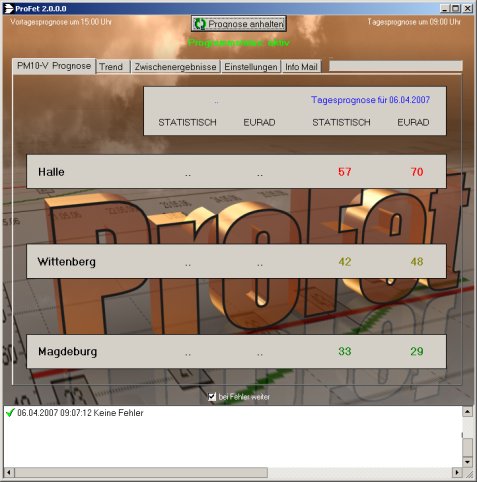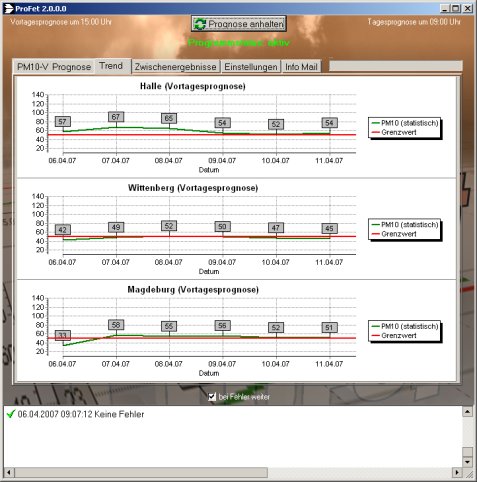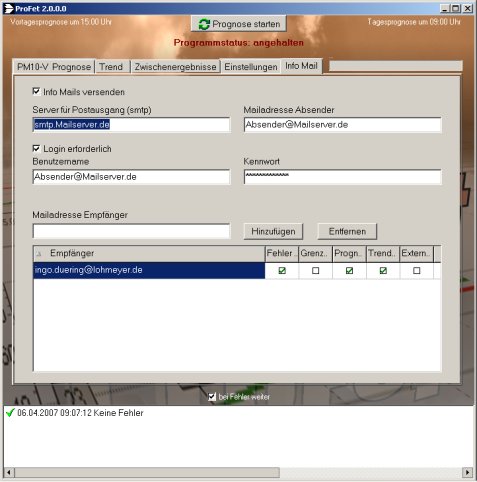 |
... software for the particulate matter forecast
for the current day and the next days
|
Particulate matter (PM10) pollution is a decisive component with effects on our health as well as the climate and is thus in the focus of public, political, but also economic interest.
As a result of the 39th Federal Immission Control Ordinance (BImSchV), which, among other things, transposed EU Directive 1999/30/EC of 22 April 1999 on limit values for sulphur dioxide, nitrogen dioxide and oxides of nitrogen, particulate matter and lead in air into German law, the Länder and local authorities have been faced with the task of complying with the specified limit values for PM10 by taking appropriate measures since 2005. In particular, compliance with the PM10 daily limit value is difficult.
The engineering office Lohmeyer GmbH therefore developed the software for short-term particulate matter forecasting ProFet, which is able to estimate the particulate matter pollution of the coming days on a daily basis. This provides the authorities and municipalities with a system to detect impending limit exceedances at an early stage, to evaluate them and to react with preventive measures and also to be able to justify this necessity.
ProFet (see publication here) is currently being used successfully by the Saxony-Anhalt Air Monitoring System (LÜSA) of the State Office for Environmental Protection (LAU). Here, the expected daily PM10 mean values (µg/m³) for the traffic stations in Halle, Magdeburg and Wittenberg are calculated in each case as a current daily forecast at 9:00 a.m. and as a forecast for the following day (previous day forecast at 3:00 p.m.). It also serves as an environmental module for environmentally sensitive traffic management in Lutherstadt Wittenberg (temporary truck diversion, see e.g. LRP Wittenberg, Appendix D) as well as in Halle/Saale (temporary 30 km/h speed limit in Merseburger Straße).

In addition, a trend estimate is made for the next five days.


The prediction models are based on statistical evaluations of extensive measurement series (concentrations and meteorological data). Thereby, the PM10 concentrations showed a clear dependence on meteorological parameters, such as temperature, precipitation, inversion and wind speed, but also the season and the day of the week, as well as the measured particulate matter concentration on the previous day and in the early morning. Accordingly, using the previously mentioned parameters, the expected PM10 daily mean values are forecast on the basis of forecasts of the German Weather Service (DWD) and measurements of the air monitoring system (LÜSA).
For the forecast for the current and the following day, two forecast values based on different approaches are offered in each case in order to take into account the site-related differences in regional background pollution as well as the scope and quality of the input data and still achieve a high forecast accuracy.
The first forecast approach is based on a classical statistical regression analysis on the basis of the described input data. In addition, the second forecast approach takes into account the results of the Europe-wide PM10 forecast model EURAD, which is operated by the Rhenish Institute for Environmental Research at the University of Cologne, for the determination of the regional background concentration. This forecasting approach can be optionally switched on. The EURAD data are then automatically updated daily by an FTP client integrated in the forecasting system.
Forecast results, diagrams and predefined notifications can be sent via an internal e-mail distribution list and, on request, also via SMS. The options as to when an e-mail is sent (for every forecast or only when limits are exceeded) with which content (notification, forecast values, with or without diagram) can be defined separately for each recipient. In this way, selected persons and decision-makers can be informed in a timely and targeted manner.

ProFet works completely autonomously according to a defined schedule. For example, the input data is checked half an hour before each forecast to ensure that it is up-to-date and complete. The result of the error check can then also be sent automatically to the appropriate persons (e-mail distribution list/SMS), which makes it possible to close any gaps that may occur in the input data.
In order to achieve the highest possible flexibility with regard to the application and expansion of the forecasting system (e.g. in the event of a change in the input data set), the system has been programmed in a modular design, thus enabling rapid adaptation, also to the conditions at other locations.
If you have any questions, please contact Dipl.-Geogr. Tilo Hoffmann by phone 0351/83914-19 or by e-mail tilo.hoffmann@lohmeyer.de.